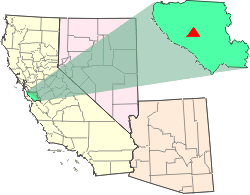
State: California(CA)
County: Santa Clara
City: San Jose
Congressional District: 16
Other Names: Fairchild Camera and Instrument Corporation Schlumberger Technology Corporation
Bulletin Board
EPA and the State of California completes fifth Five Year Review in August 2014
The review concluded that the Site is protective but recommended that certain long-term issues should be considered. See below for the latest information. Click here to read the report.
NPL Listing History
Deleted Date:
The 22-acre Fairchild Semiconductor Corp. (Fairchild) facility (former South San Jose Plant or Site) is located west of Highway 101 about nine miles southeast of downtown San Jose near the intersection of Monterey Highway and Highway 85. The Site is located in a light industrial and commercial area. The plant was constructed between 1975 and 1977 and used for electronics and semiconductor fabrication from 1977 to 1983. Solvents containing volatile organic compounds (VOCs; primarily 1, 1, 1-TCA) were used at the Site. Other chemicals, such as acids, were also used and stored at the Site. The Site was vacant from 1983 until it was redeveloped and reoccupied in 2000. From 1979 until 1987, Fairchild was a wholly owned subsidiary of Schlumberger Technology Corporation (STC). STC sold Fairchild to National Semiconductor Corporation in 1987, but retained the Site. STC sold the Site to a commercial developer in 1990. The Site was redeveloped as a retail shopping center (commercial) by parties other than STC in 2000. STC has remained the responsible party for Site cleanup.
Initial investigations were conducted in November/December 1981 and determined that compounds of concern (COCs) were in soil and groundwater at the Site. The investigation identified a single source: a 5, 940-gallon underground waste storage tank. The COCs included 1, 1, 2-trichloro-1, 2, 2-trifluoroethane (Freon 113), 1, 1, 1-TCA, acetone, isopropyl alcohol, tetrachloroethene, xylenes, and 1, 1-DCE, which is a degradation product of 1, 1, 1-TCA.
In 1981, samples from Great Oaks Water Company drinking water supply well GO-13, located down-gradient from the Site, contained 1, 1, 1-TCA. 1, 1, 1-TCA was one of the COCs detected in soil and groundwater near the underground tank at the Site. Well GO-13 was taken out of service in December 1981 and used for remediation until it was sealed in October 1986.
Remedial action at the Site began in 1982 with the removal of the underground waste storage tank and associated piping. Additional facilities that were removed in 1982 included an acid waste tank, concrete holding vault, concrete slab beneath the former waste solvent tank, and a temporary waste solvent tank. After removal of the underground waste storage tank in 1982, about 3, 400 cubic yards of soil were excavated from the vicinity of the tank to a total depth of 52 feet below grade. Groundwater extraction at the Site was also initiated in 1982 to control migration of COCs.
In 1986, Fairchild constructed a slurry cut-off wall around the Site to a maximum depth of 148 feet to create a physical barrier to prevent off-property migration of COCs. Groundwater extraction and treatment (GWET) continued inside and down-gradient from the slurry wall enclosure until 1998 and 1991, respectively. Soil excavation and construction of the slurry wall were complete and the GWET system and groundwater monitoring program were implemented by the time the Final Site Cleanup Requirements Order (SCR) was adopted in 1989.
As indicated above, groundwater remediation began at the Site in 1982. Fairchild identified and closed all supply wells in the area that were impacted by COCs. With concurrence from the Regional Water Board, Fairchild suspended groundwater extraction and treatment in July 1998 after demonstrating that asymptotic VOC concentrations and other conditions had been reached. During operation of the GWET system between 1982 and 1998, a total of 93, 285 pounds of VOCs were removed from groundwater.
A soil vapor extraction and treatment (SVET) system was operated at the Site in 1989 and 1990 to treat and remove COCs in air pores located in soil above groundwater. The SVET was removed in 1995 with Regional Water Board approval when Fairchild demonstrated that soil cleanup standards established in the SCR had been achieved. A total of 15, 906 pounds of VOCs were removed by SVET.
In total, approximately 147, 000 pounds of VOCs were removed from the Site through soil excavation, groundwater extraction, and soil vapor extraction. In 1998, the Regional Board approved suspension of active remediation at the Site. Fairchild has continued monitoring of on-Site and off-Site groundwater and of the slurry cut-off wall since 1998 and providing annual reports to the Regional Water Board.
Contaminated Media
- Groundwater
- Soil and Sludges
COCs in soil and groundwater were discovered in 1981. The potential threat of direct contact with contaminated soil has been eliminated through initial actions. All private supply wells located in the area surrounding the site have been sealed or abandoned. The plume of groundwater containing COCs has been significantly reduced through extraction, treatment, and natural attenuation, and the potential health threat posed by ingesting groundwater contaminants continues to decrease. In 2009, the Regional Water Board and EPA evaluated the potential for COCs migrating through vapor intrusion (VI) into surface uses at the Site. The evaluation found no unacceptable risk of VI. At the request of the Regional Water Board and EPA, Fairchild re-evaluated the potential VI risks in 2014. Fairchild’s evaluation concluded that residual COCs in groundwater do not present a health risk to on-Site or off-Site buildings from VI. EPA and the Regional Water Board are currently reviewing Fairchild’s conclusions regarding the VI pathway.